Wingspan 20 m Introduced May 1951 | Length 20 m Retired 23 June 2006 First flight May 13, 1949 | |
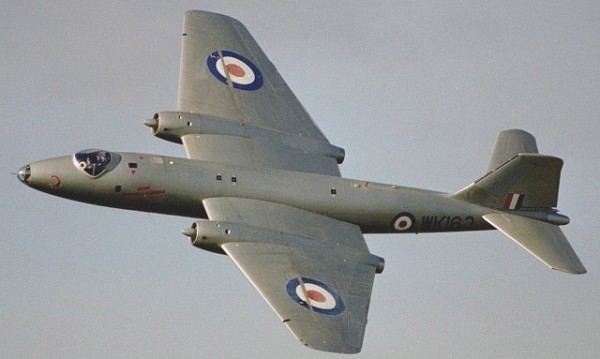 | ||
The English Electric Canberra is a British first-generation jet-powered medium bomber that was manufactured during the 1950s. It was developed by English Electric during the mid-to-late 1940s in response to a 1944 Air Ministry requirement for a successor to the wartime de Havilland Mosquito fast-bomber; amongst the performance requirements for the type was the demand for an outstanding high altitude bombing capability in addition to flying at high speeds, these were partly accomplished by making use of newly developed jet propulsion technology. When the Canberra was introduced to service with the Royal Air Force (RAF), the type's first operator, in May 1951, it became the service's first jet-powered Bomber aircraft.
Contents
- English electric canberra cold war bomber rc dave johnson lma raf cosford 2016
- Background
- Prototypes and first flights
- Production and licensed manufacturing
- Photo reconnaissance and specialised roles
- Design
- Royal Air Force
- Royal Australian Air Force
- Indian Air Force
- Africa
- Sweden
- South America
- Argentina
- Development and trials aircraft
- Flight records set by Canberras
- Variants
- Operators
- Survivors
- Australia
- India
- Malta
- South Africa
- United Kingdom
- United States
- Specifications Canberra BI6
- References
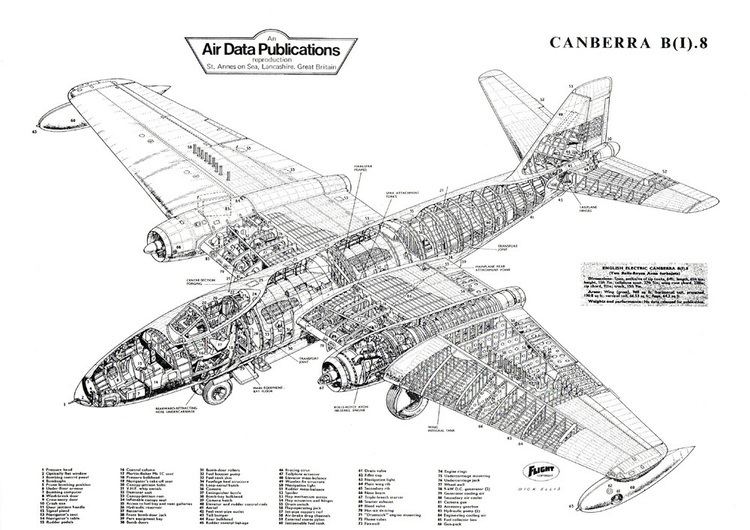
Throughout the majority of the 1950s, the Canberra could fly at a higher altitude than any other bomber or even any other aircraft in the world. In 1957, one Canberra established a world altitude record of 70,310 ft (21,430 m). In February 1951, another Canberra set another world record when it became the first jet aircraft to make a non-stop transatlantic flight. Due to its ability to evade the early jet interceptor aircraft and its significant performance advancement over contemporary piston-engined bombers, the Canberra became a popular aircraft on the export market, being procured for service in the air forces of many nations both inside and outside of the Commonwealth of Nations. The type was also licence produced in Australia and the United States of America, the latter building it as the Martin B-57 Canberra.
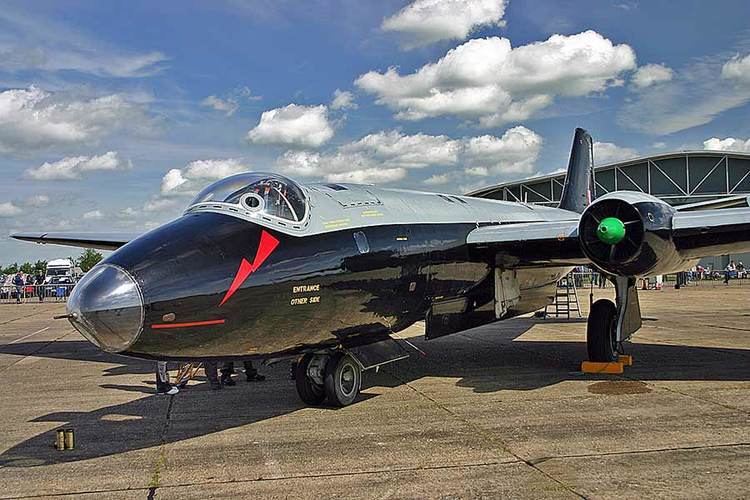
In addition to being a tactical nuclear strike aircraft, the Canberra proved to be highly adaptable, serving in varied roles such as tactical bombing and photographic and electronic reconnaissance. Canberras served in the Suez Crisis, the Vietnam War, the Falklands War, the Indo-Pakistani wars, and numerous African conflicts. In several wars, each of the opposing sides had Canberras in their air forces. The Canberra had a lengthy service life, serving for more than 50 years with some operators. In June 2006, the RAF retired the last of its Canberras, 57 years after its first flight. Three of the Martin B-57 variant remain in service, performing meteorological work for NASA, as well as providing electronic communication (Battlefield Airborne Communications Node or BACN) testing for deployment to Afghanistan.
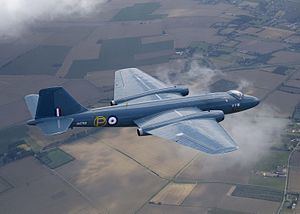
English electric canberra cold war bomber rc dave johnson lma raf cosford 2016
Background
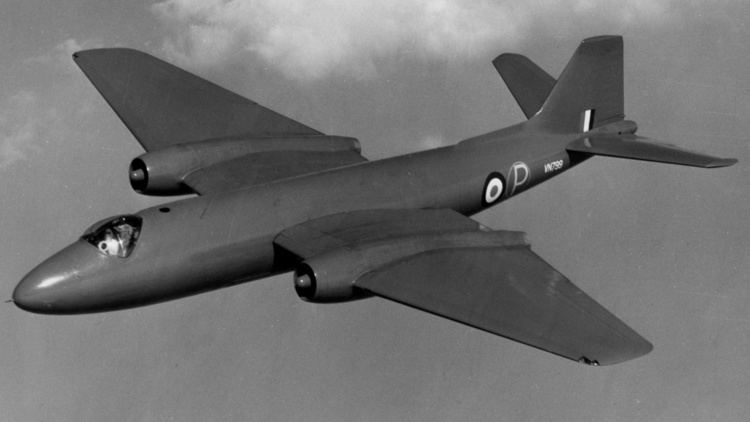
During the Second World War, a desperate demand for bomber aircraft led to many aircraft being produced by secondary manufacturers via licence manufacturing arrangements. The English Electric company mass-produced thousands of piston-engined bombers, such as the Handley Page Hampden and Handley Page Halifax, in this manner and the firm thus became a well-established British aircraft manufacturer despite having little internal design experience. Sir George Nelson, the chairman of English Electric, decided that the company would seek to remain in the business and produce its own designs. In November 1943, the company was invited to participate in discussions over a prospective bomber which would take advantage of the newly developed jet propulsion technology.
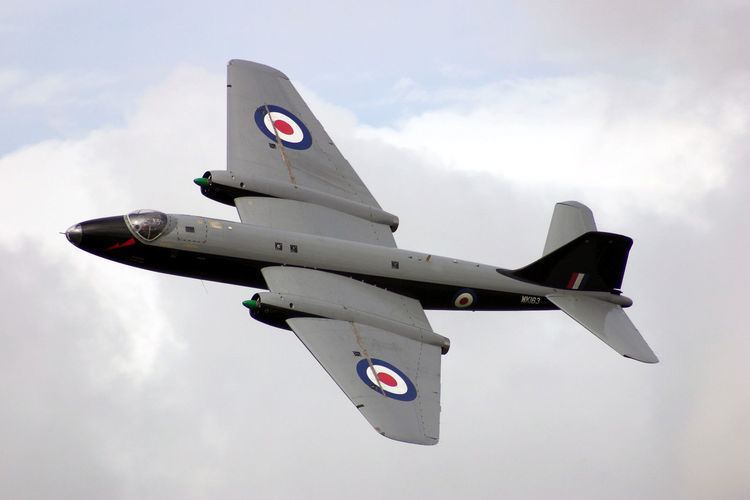
In 1944, Westland Aircraft's technical director and chief designer W. E. W. Petter had prepared a design study for a twin-engined fighter bomber, the P.1056, based on two fuselage-mounted Metrovick F.2/4 "Beryl" engines. The design used a relatively conventional aerodynamic design, Petter having determined that the necessary performance could be attained without adopting swept wings or a swept tail. The authorities doubted its suitability for operations from unprepared fields and at low altitude but could see its potential as a bomber design; numerous manufacturers refused to take on the design. Petter left Westland to join the English Electric company in December 1944, where he was appointed by Nelson to form a design team and encouraged to develop his design. In 1945, English Electric formalised its own in-house aircraft design team to pursuit this design.
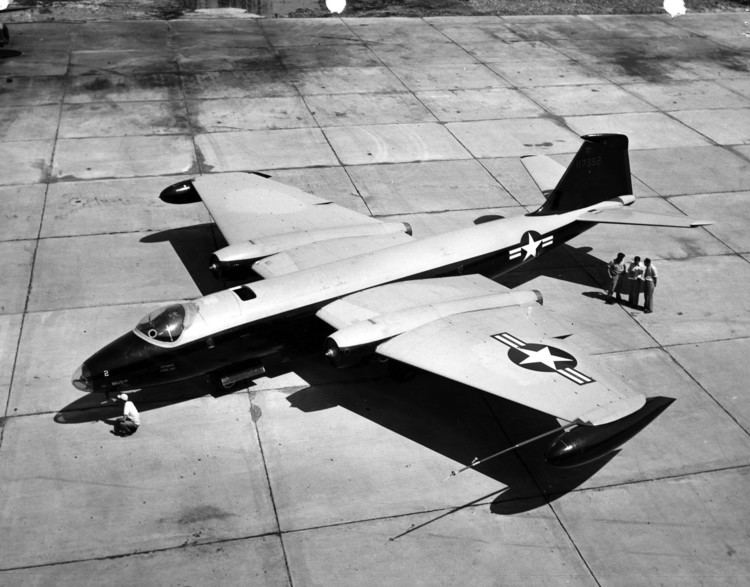
The Canberra had its formal origins in a 1944 requirement issued by the Air Ministry for a successor to the de Havilland Mosquito. This requirement, the initial revision being E.3/45, sought a high altitude, high-speed bomber which was to be equipped with no defensive armament. According to aviation historians Bull Gunston and Peter Gilchrist, Air Ministry officials are alleged to have had difficulty defining what they sought for the proposed type, which led to several revisions of the requirement. Further specification refinements were issued, including B.3/45 and B.5/47, issued further details such as a three-man crew and other features such as a visual bombing capability. Several British aircraft manufacturers submitted proposals to meet the requirement, including English Electric. The firm was among those companies to be short-listed to proceed with development studies.
By June 1945, the aircraft that was to become the Canberra bore many similarities to the eventual design, despite the placement of a single, centrally mounted turbojet engine; Petter had held discussions with Rolls-Royce Ltd on the topic of the development of a scaled-up derivative of the Nene engine. In late 1945, the design was modified further with a pair of engines being adopted instead, initially to be set in the wing roots and later to be mounted in a mid-wing position; this change was made principally due to centre of gravity issues imposed by the position and weight of a heavy bombload and centrally-mounted single engine. The new engine position decreased the aircraft's weight by 13 per cent and improved the aircraft's centre of gravity, as well as improved accessibility to the engines and related accessories, downsides were slightly elevated losses in the longer jet pipes and greater yaw during engine-out instances.
During the early design stages, the aircraft had grown from being roughly the same size as the Mosquito to being around double its weight. Although jet-powered, the Canberra design philosophy was very much in the Mosquito mould, providing room for a substantial bomb load, fitting two of the most powerful engines available, and wrapping it in the most compact and aerodynamic package possible. Rather than devote space and weight to defensive armament which historically could not overcome fighter aircraft, the Canberra was designed to fly fast and high enough to avoid air-to-air combat entirely. On 7 January 1946, the Ministry of Supply placed a contract for the development and production of four English Electric A.1 aircraft. It continued to be known as the English Electric A.1 until it was given the name Canberra after the capital of Australia in January 1950 by Sir George Nelson, chairman of English Electric, as Australia had become the aircraft's first export customer.
Prototypes and first flights
The Air Ministry specification B.3/45 had requested the production of four prototypes. On 9 January 1946, English Electric received a contract to produce four prototypes, which received the Society of British Aerospace Companies (SBAC) designation A.1; work commenced on the construction of these prototype aircraft in that same year, which were all built on production jigs. However, progress was slow due to several factors, such as the protracted development of the Avon engine that powered the type; in October 1947, in response to Rolls-Royce's difficulties, English Electric elected to have the second prototype modified to use the existing Nene engine in place of the Avon. The implementation of post-war military cutbacks also served to slow development.
A further external issue that affected development was the failure of the Telecommunications Research Establishment to produce the intended radar bombing system for the aircraft in a timely fashion; this required a redesign in 1947, changing the aircraft's nose to accommodate a glazed tip for visual bombing by a bomb aimer, which in turn required the cockpit to be restructured to facilitate the ejection system of the additional crewmember. In 1948, the design team relocated to Warton Aerodrome, Lancashire; establishing a flight test organisation and assembly facilities there.
Ultimately, the first of these prototypes, VN799 did not conduct its maiden flight until 13 May 1949. Piloted by Roland Beamont, the aircraft is claimed to have handled well with the exception of a rudder overbalance issue encountered. This initial flight was flown with the intended Avon engines, the decision to perform the type's first flight with the Avon-equipped first prototype or the Nene-equipped second prototype, VN828, was not made until weeks beforehand. On 9 November 1949, the second prototype, VN828, the first to be equipped with the Nene engine, performed its first flight; the third and fourth followed within the following eight weeks.
Flight testing of the prototypes proved to be vice-free and required only a few modifications to be made. The changes included the installation of a glazed nose to accommodate a bomb-aimer, due to the advanced H2S Mk9 bombing radar not being ready for production, the turbojet engines that powered the type were replaced by the more powerful Rolls-Royce Avon R.A.3s, and distinctive teardrop-shaped fuel tanks were fitted under the wingtips. Refinements were also quickly made following early flight testing to the rudder and elevator to reduce instances of buffeting, after which it is claimed that the Canberra handled much like a fighter, proving to be atypically manoeuvrable for a bomber.
The project had found considerable support from the government in the late 1940s. In March 1949, in advance of the maiden flight of the first prototype, English Electric received an instruction to proceed for production. By the time the first prototype had flown, the Air Ministry had already placed orders for 132 production aircraft in bomber, Reconnaissance, and training variants. On 21 April 1950, the first production-standard aircraft, designated as the Canberra B2, conducted its maiden flight, piloted by Beamont. Proving to be fairly free of problems, this first flight was almost immediately followed by the mainstream manufacturing of production Canberras. In May 1951, the Canberra entered RAF squadron service, No. 101 Squadron being the first to receive the type. In a testament to the aircraft's benign handling characteristics, the transition programme for the Canberra consisted of only twenty hours in the Gloster Meteor and three hours in a dual-control Canberra trainer.
Production and licensed manufacturing
In July 1949, as English Electric was in the process of setting up production at Samlesbury Aerodrome, a firm order was placed for 132 Canberras; this order consisted of 90 B.5/47 bomber-type aircraft, 34 PR.31/46 photo reconnaissance aircraft, and 8 T.2/49 trainer aircraft. On 25 June 1950, what would become known as the Korean War broke out; this led to a surge of demand for the Canberra and the British government stepping in to establish a far greater level of wartime production. This led to a succession of orders for Canberra B.2s, the initial bomber variant, being placed with Avro, Handley Page, and Short Brothers; for British needs alone, English Electric produced 196 B.2s, Avro and Handley Page manufactured 75 each, and Short completed 60 aircraft - the B.2 variant of the Canberra exceeded the numbers built of any other version. Other nations, notably Australia and the United States of America, also ordered large quantities of Canberras.
In the United States, the US Air Force had identified the need to replace the obsolete B-26 Invader and had determined that, at the time, no home-produced aircraft designs could get close to what the Canberra could already offer. Following a competition against rivals such as the Martin XB-51, it was decided to order a total of 403 Canberras. These aircraft were manufactured under licence by Martin as the B-57 Canberra, who would develop several versions of the aircraft themselves. The first examples were the identical to the original English Electric aircraft, following which tandem crew seating was introduced, but later B-57 models were considerably modified.
Australia had been interested in the Canberra early on, which had led to the aircraft being named after the Australian capital city. Particular interest had at one time been expressed in a potential Rolls-Royce Tay powered version of the aircraft. The Government Aircraft Factories (GAF) locally assembled 48 for the Royal Australian Air Force. These aircraft were broadly similar to the British B.2. Changes included the adoption of a modified leading edge, increased fuel capacity and room for three starter cartridges, although in practice all three cartridges would sometimes fire, leading to the triple starter units being loaded singly. In addition, Australian built Canberras used a higher proportion of Australian and US sourced components.
A total of 901 Canberras were manufactured by the various UK based aircraft manufacturers; when combined with overseas license production operations, the overall global production for the Canberras totaled 1,352 aircraft. With a maximum speed of 470 knots (870 km/h; 540 mph), a standard service ceiling of 48,000 ft (14,600 m), and the ability to carry a 3.6-tonne (7,900 lb) payload, the Canberra proved to be an instant success on the domestic and export markets. It was built in 27 versions that equipped a total of 35 RAF squadrons, and was exported to more than 15 countries, including Australia, Argentina, Chile, Ecuador, Ethiopia, France, India, New Zealand, Pakistan, Peru, Rhodesia, South Africa, Sweden, Venezuela and West Germany.
Photo-reconnaissance and specialised roles
During the latter part of the Second World War, strategic reconnaissance missions performed by the RAF had been carried out by the de Havilland Mosquito. In 1946, the Air Ministry issued Specification PR.31/46 seeking a jet powered replacement for the Mosquito. To meet the requirement, the B2 design was modified by adding a 14-inch (36 cm) bay forward of the wing behind the cockpit to house seven cameras. It also had an additional fuel tank in the forward part of the bomb bay and only needed a two-man crew. The prototype, designated PR3, first flew on 19 March 1950, followed by the first of 35 production aircraft on 31 July 1952. In December 1952, the PR3 entered RAF service, at which point No. 540 Squadron RAF began converting from its Mosquito PR.34 force. The Canberra PR3 was the first aircraft to be designed for the RAF purely to perform photo reconnaissance missions.
The initial Canberra PR3 model was shortly succeeded by the improved PR7 variant. The PR7 featured greater fuel capacity via wing storage, the more powerful RA.7 model of the Avon engine, and Maxaret anti-lock braking system. The Canberra PR9 was the final photo reconnaissance version; this aircraft was furnished with a new crew compartment, a redesigned inner wing section, and much more powerful RA.24 Avon engine. In later service, bomber models of the Canberra were often converted with cameras and other equipment suited for reconnaissance purposes.
To enable crews to convert to flying the Canberra, a trainer version was developed to meet Air Ministry Specification T2/49. On 12 June 1951, the prototype, designated T4, conducted its first flight. It was the same basic design as the B2 apart from the introduction of side by side seating for the pilot and the instructor and the replacement of the glazed nose with a solid nose. The first production T4 flew on 20 September 1953 and the variant entered service with No. 231 Operational Conversion Unit RAF in early 1954. In addition to those assigned to the operational conversion unit, all of the B2 equipped bomber squadrons received at least one T4 for training purposes.
In addition to the RAF, other users adopted the Canberra in the trainer role. The Indian Air Force (IAF) operated a number of T4 aircraft for conversion training purposes. The RAAF adopted the Australian built Canberra T21 model, which was broadly similar to the T4. Argentina procured a pair of T64 trainers during the 1970s.
From 1960s onwards, increasing numbers of bomber orientated Canberras were deemed surplus as newer, faster ground attack aircraft were introduced; this led to such aircraft being rebuilt to serve in various alternative roles, including unpiloted target aircraft, radar trainers, target tugs, radar calibration aircraft, and electronic countermeasures trainers. In addition, some Canberras that had originally been manufactured for the high altitude bomber mission were reequipped for low altitude ground attack missions.
Design
The English Electric Canberra is a twin-engine bomber aircraft, capable of conducting high-altitude flights and making use of jet propulsion. The overall design has been described as being of a simple nature, somewhat resembling a scaled-up Gloster Meteor fighter, except for its use of a mid-wing. The Canberra principally differed from its preceding piston-powered wartime bombers via its twin Rolls-Royce Avon turbojet engines. The fuselage was circular in cross section, tapered at both ends and, cockpit aside, entirely without protrusions; the line of the large, low-aspect ratio wings was broken only by the tubular engine nacelles. The Canberra had a two-man crew under a fighter-style cabin which was furnished with a large blown canopy, but delays in the development of the intended automatic radar bombsight resulted in the addition of a bomb aimer's position housed within the nose. The pilot and navigator were positioned in a tandem arrangement on Martin-Baker ejection seats.
The wing is of single-spar construction that passes through the aircraft's fuselage. The wingspan and total length of the Canberra are almost identical at just under 20 metres. Outboard of the engine nacelles, the wing has a leading edge sweep of 4° and trailing edge sweep of −14°. All flight controls are manual, using push-rods rather than cables, but are otherwise conventional. These actuate the aircraft's flight control surfaces, including shrouded-nosed ailerons, four-section conventional split-type flaps, and atypical airbrakes which comprise 40 hydraulically-raised fingers located on the top and bottom surfaces of the wings. Swept-wings were considered, but not adopted, since the expected operational speeds did not warrant them and because they could have introduced new aerodynamic problems into what was otherwise anticipated to be a straightforward replacement for RAF Hawker Typhoon and Westland Whirlwind fighter-bombers.
The fuselage of the Canberra is of semi-monocoque construction with a pressurised nose compartment. The whole lower section of the fuselage is taken up by the sizable bomb bay, which was typically covered by a pair of hydraulically-driven doors. The Canberra's undercarriage used a simple arrangement, the main landing gear being equipped with a single outboard-mounted wheel and the nose gear being a twin-wheel arrangement. Due to the use of a new alloy, DTD683, the undercarriage suffered from stress corrosion, causing decay to start within only a few years. The extreme hazard posed of undercarriages collapsing during landings, especially if the aircraft were carrying nuclear weapons, led the RAF to institute regular inspections, at first using radiography before moving to more effective and reliable ultrasound technology. The Canberra is made up mostly of metal, only the forward portion of the tail-fin is made from wood.
Thrust was provided by a pair of 30 kN axial flow Rolls-Royce Avon turbojet engines. These were directly mounted in the midsection of the wings using tubular trusses and links between the main mounts and the adjacent leading edge of the wing. Each engine drove a 6-kW generator for the 28-V onboard electronics, as well as a hydraulic pump and a bleed air system for cabin pressurization. The wing itself was typically empty, fuel was contained within two internally-support self-sealing fuel tanks and an additional lace-support bag held within the upper fuselage. The manufacturer specified that Coffman engine starters should be used to start the engine. An improvised method of starting the engine using compressed air was heavily discouraged by Rolls-Royce, but some operators successfully operated the Canberra's engines in such a manner, the benefit being significant cost savings over the use of cartridges.
Various avionics were installed on the Canberra, many of these had their origins within the Second World War. Such systems include Gee-H navigation, Rebecca beacon-interrogation distance-measuring equipment, very high frequency (VHF) radio, radio compass, radar altimeter, identification friend or foe (IFF), and Orange Putter radar warning receiver. Perhaps the most crucial of the mission systems was the HS2 automatic radar bombsight, which was mounted in the nose; delays in the development of the HS2 model intended for the Canberra led to early models being fitted with a T.2 optical sight for visual bombing in its place, which was considerably inferior to the radar-guided counterpart when attacking ground targets while flying at high altitudes.
The Canberra could deploy many conventional weapons, typical weapons used were 250-pound, 500-pound, and 1000-pound bombs, the total bomb load could weigh up to 10,000 pounds (4.5 t). Two bomb-bays are housed within the fuselage, these are normally enclosed by conventional clam-shell doors; a rotating door was substituted for these on the Martin-built B-57 Canberras. Additional stores up to a total of 2,000 pounds (0.91 t) could be carried upon underwing pylons. Operators often developed and installed their own munitions, such as Rhodesia's anti-personnel bomblets, the Alpha bomb, a varied range of munitions were employed on Canberra fleets around the world. Anti-personnel flechette bombs were tested successfully from the Canberra by Rhodesia, but not used operationally due to international agreements.
In part due to its range limitation of just 2,000 miles (3,200 km), and its inability to carry the early, bulky nuclear bombs, the Canberra was typically employed in the role of a tactical bomber as opposed to that of a strategic one. In British service, many of the Canberras that were stationed at remote overseas locations did not undertake modifications to become nuclear-capable until as late as 1957.
Royal Air Force
The Canberra B2 started to enter service with 101 Squadron in January 1951, with 101 Squadron being fully equipped by May, and a further squadron, No. 9 Squadron equipping by the end of the year. The production of the Canberra was accelerated as a result of the outbreak of the Korean War, orders for the aircraft increased and outpaced production capacity, as the aircraft was designated as a "super priority". A further five squadrons were able to be equipped with the Canberra by the end of 1952; however, production in the 1951–52 period had only been half of the level planned, due to shortages in skilled manpower, material, and suitable machine tools.
The Canberra replaced Mosquitos, Lincolns and Washingtons as front line bombers, showing a drastically improved performance, and proving to be effectively immune from interception during air defence exercises until the arrival of the Hawker Hunter. The Canberra also replaced the RAF's Mosquitos in the reconnaissance role, with the Canberra PR3 entering service in December 1952. The improved Canberra B6, with more powerful engines and a greater fuel capacity, started to supplement the B2s in the UK based squadrons of Bomber Command from June 1954, when they replaced 101 Squadrons B2s. This freed up older B2s to allow Canberra squadrons to form overseas, with bomber and reconnaissance Canberra wings forming in RAF Germany and on Cyprus, with squadrons also being deployed to the Far East.
The PR7 variant of the Canberra, equipped with longer, fuel-filled wings and the Avon 109 engines, executed a 1953 reconnaissance flight over the Soviet rocket launch and development site at Kapustin Yar, although the UK government has never admitted the existence of such a flight. Warned by either radar or agents inside the British government, the Soviets slightly damaged one aircraft. Further reconnaissance flights are alleged to have taken place along, and over, the borders of the Soviet Union in 1954 under the code name Project Robin, using the Canberra B2 WH726. The USAF also used the Canberra for reconnaissance flights. The aircraft were no longer required after June 1956, following the introduction of the US Lockheed U-2 purpose-built reconnaissance aircraft; Project Robin was then terminated. These RAF Canberra overflights were later featured in the 1994 BBC Timewatch episode; "Spies in the Sky", and included interviews with some of the Soviet MiG-15 pilots who had attempted to intercept them.
The Canberra was the victorious aircraft flown in The Last Great Air Race from London to Christchurch in 1953, piloted by Flight Lieutenant Roland (Monty) Burton, which touched down at Christchurch 41 minutes ahead of its closest rival – after 23hr 51min in the air; to this day the record has never been broken.
The Vickers Valiant entered service in 1955, capable of carrying much heavier weapon loads (including the Blue Danube nuclear weapon) over longer ranges than the Canberra. This led to the Bomber Command force of Canberras equipped for high-level conventional bombing to be gradually phased out. This did not mean the end of the Canberra in front line service, as it proved suitable for the low-level strike and ground attack role, and versions dedicated to this role were brought into service. The interim B(I)6, converted from the B6 by adding provision for a pack of four Hispano 20 mm cannon in the rear bomb bay and underwing pylons for bombs and rockets, entered service in 1955, with the definitive, new build B(I)8, which added a new forward fuselage with a fighter-style canopy for the pilot, entering service in January 1956.
An important role for the new low-level force was tactical nuclear strike, using the Low Altitude Bombing System (LABS) to allow a nuclear bomb to be delivered from low level while allowing the bomber to escape the blast of the weapon. RAF Germany's force of four squadrons equipped with the B(I)6 and B(I)8 could carry US-owned Mark 7 nuclear bombs from 1960, which were replaced by B43 nuclear bombs, also US-owned, from 1965. Three squadrons based on Cyprus and one at Singapore were armed with British-owned Red Beard nuclear weapons.
Bomber Command retired the last of its Canberras on 11 September 1961, but the Germany, Cyprus and Singapore based squadrons continued in the nuclear strike role. The Cyprus-based squadrons and one of the RAF Germany squadrons disbanded in 1969, with the Singapore-based unit followed in 1970. The three remaining RAF Germany units, which by now had replaced the old Mark 7 bombs with newer (but still US-owned) B43 nuclear bombs, remained operational until 1972, the last Canberra bombers in RAF service.
The RAF continued to operate the Canberra after 1972, employing it for reconnaissance (with Squadrons equipped with PR7s and PR9s being based at RAF Wyton in the UK and RAF Luqa in Malta). The PR9s were fitted with special LOROP (Long-Range Optical Photography) cameras, reportedly based on those used by the Lockheed U-2, to allow high-altitude of targets deep into Eastern Europe while flying along the inner German border, as well as infrared linescan cameras for low level night reconnaissance. The RAF used Canberras to search for hidden arms dumps using false-colour photography during Operation Motorman in July 1972, when the British Army re-took Irish republican held "no go areas" in Belfast and Derry. Canberras were used for reconnaissance during the Bosnian War during the 1990s, where they were used to locate mass graves and during the Kosovo War in 1999. They were also operated from Uganda during the First Congo War, where they were used to search for refugees. Small numbers of specially equipped Canberras were also used for signals intelligence, being operated by 192 Squadron and then 51 Squadron from 1953 to 1976.
During the Falklands War, a plan to supply two PR9s to the Chilean Air Force, and secretly operate them with RAF crews over the war zone, was abandoned for political reasons. The aircraft got as far as Belize before the operation was cancelled. The PR9 variant remained in service with No. 39 (1 PRU) Squadron until July 2006 for strategic reconnaissance and photographic mapping, seeing service in the 2003 invasion of Iraq and, up to June 2006, in Afghanistan. During a ceremony to mark the standing down of 39 (1 PRU) Squadron at RAF Marham on 28 July 2006, a flypast by a Canberra PR9 on its last ever sortie was conducted.
Royal Australian Air Force
Shortly after the end of the Second World War, the Australian government initiated a wide-scale reorganisation of the armed forces. As part of this process, the Royal Australian Air Force (RAAF) developed Plan D as the basis for its postwar structure; Plan D was built around the concept of a numerically smaller but more agile air arm that would employ leading edge technology. During the late 1940s, the RAAF decided to acquire the Canberra as a replacement for, or complement to, the Avro Lincoln, though fears were raised that the new design was not especially advanced. While Australia never introduced nuclear weapons into service, the Canberra's ability to carry such a payload was a stated factor in its acquisition; Australia's planned force of 48 Canberras, which held the potential for being nuclear-armed, was viewed as far more potent and deterring to potential opponents than the RAAF's entire wartime forces of 254 heavy bombers.
The Australian government decided that the RAAF's Canberras would be constructed domestically by the Government Aircraft Factories (GAF) as opposed to being manufactured in the UK. On 29 May 1953, the first Australian-built Canberra performed its first flight at Avalon Airport, Victoria; this aircraft was delivered to the RAAF for service trials a few weeks later. In December 1953, the Canberra formally entered Australian service.
From July 1950 to July 1960, during the Malayan Emergency, Canberras from Australia, New Zealand and the UK were deployed into the Malaysia to fight against Communist guerillas. In 1967, the RAAF deployed eight Canberras to the Vietnam War. The unit, No. 2 Squadron, was later commended for its performance by the United States Air Force. The Canberras were typically operated in the low-level bombing role, taking over South Vietnam's southern most military regions III and IV responsibilities allowing USAF bombers to deploy their aircraft to the Ho Chi Minh trail. While USAF Canberras were equipped with .50 caliber machine guns or 20mm cannon for strafing, Australian Canberras were deployed to South Vietnam without guns, hence were deployed strictly for low level bombing missions. Upon their re-deployment from Vietnam in 1971, No. 2 Squadron had flown approximately 12,000 sorties and dropped 76,389 bombs, and lost two of their aircraft to missiles and ground fire during the course of the war.
As early as 1954, Australia recognised that the Canberra was becoming outdated, and evaluated aircraft such as the Avro Vulcan and Handley-Page Victor as potential replacements. The Canberra was incapable of providing adequate coverage of Indonesia from Australian bases, and was evaluated as having a "very low" chance of survival if it encountered modern fighters like the MiG-17. Political pressure for a Canberra replacement rose to a head in 1962. Australia evaluated the BAC TSR-2, Dassault Mirage IV, McDonnell Douglas F-4 Phantom II and North American A-5 Vigilante, and initially appeared to favour the TSR-2, but chose to procure the General Dynamics F-111C in October 1963. Due in part to delays in the delivery of the F-111Cs, the Canberra continued to be used by Australia for a total of 29 years before its retirement in June 1982.
Indian Air Force
The Canberra was the backbone of the Indian Air Force (IAF) for bombing raids and photo-reconnaissance for many decades. Negotiations to acquire the Canberra as a replacement for the obsolete Consolidated B-24 Liberator bombers then being used by India began in 1954. During the extended negotiations between Britain and India, the Soviet Union is alleged to have offered their own jet bomber, the Ilyushin Il-28, at a significantly lower price than that asked for the Canberra; by April 1956, however, the Indian government was in favour of the purchase. In January 1957 India placed a large order for the Canberra; a total of 54 B(I)58 bombers, eight PR57 photo-reconnaissance aircraft, and six T4 training aircraft were ordered, deliveries began in the summer of that same year. A total of 12 more Canberras were ordered in September 1957, as many as 30 more may have also been purchased by 1962.
First used in combat by the IAF in 1962, the Canberra was employed during the UN campaign against the breakaway Republic of Katanga in Africa. During the Indo-Pakistani Wars of the 1960s and 1970s, the Canberra was used by both sides. The most audacious use of the bomber was in the "Raid on Badin" during the Indo-Pakistani War of 1965, when the Indian Air Force sent in the Canberra to attack a critical Pakistani radar post in West Pakistan. The raid was a complete success, the radars in Badin having been badly damaged by the bombing and put out of commission. A later raid by the IAF was attempted on Peshawar Air base with the aim of destroying, amongst other targets, several Pakistani B-57 bombers, American-built Canberras. Due to poor visibility, a road outside of the base was bombed, instead of the runway where PAF B-57 bombers were parked.
During the Indo-Pakistani War of 1971, Indian Canberras flew a strategically important sortie against the Karachi oil tanks, this had the effect of helping the Indian Navy in their own operations, a series of missile boat attacks against the Pakistani coast. On 21 May 1999, prior to the commencement of the Kargil War, the Indian Air Force Air HQ assigned a Canberra PR57 aircraft on a photographic mission near the Line of Control, where it took a severe blow from a FIM-92 Stinger infrared homing missile on the starboard engine; the Canberra successfully returned to base using the other engine.
The entire Indian Air Force Canberra fleet was grounded and then retired following the crash of an IAF Canberra in December 2005. After 50 years of service, the Canberra was finally retired by the IAF on 11 May 2007.
Africa
During the Suez Crisis the RAF employed around 100 Canberras, flying conventional bombing and reconnaissance missions from airfields in Malta and Cyprus. A total of 278 Canberra sorties were flown, dropping 1,439 1000 lb (450 kg) bombs; however low-level strikes by smaller fighters were judged to be more effective than the night time bombing operations performed by both the Canberra and the Vickers Valiant. In addition, many of the bombs, intended to hit Egyptian airfields, missed their targets, failing to inflict much damage to the Egyptian Air Force or to badly demoralise the enemy. While interception of the Canberra was within the capabilities of Egypt's MiG-15s and MiG-17s, as shown by the interception of Canberras by MiG-15s prior to the Anglo-French invasion, these did not result in any losses. The only Canberra shot down during the Suez campaign was a PR7 shot down by a Syrian Gloster Meteor fighter on 6 November 1956, the last day of the war.
The Federation of Rhodesia and Nyasaland considered the Canberra an important objective to holding greater diplomatic sway in the African continent, and ongoing negotiations over the Baghdad treaty, and a step towards decolonisation. The Suez Crisis caused a delay in the sale, but in August 1957 18 Canberras had been earmarked to be refurbished and transferred from the RAF to the Royal Rhodesian Air Force (RRAF). Both Rhodesia and South Africa used Canberras in their respective Bush Wars; numerous aircraft were lost in the conflicts. Rhodesian B2 Canberras together with South African B(I)12 Canberras carried out attacks on insurgents in Mozambique, usually armed with 'Alpha' cluster bombs, several raids on Zambia, and attacks upon multiple insurgents bases in Angola. Ethiopian Canberras were used against Eritrea and again against Somalia during the 1970s.
Sweden
The Swedish Air Force purchased two Canberras from the RAF in 1960 and had these modified to T11s by Boulton Paul. The aircraft were secretly modified in Sweden as espionage aircraft for eavesdropping on primarily Soviet, Polish and East German military radio transmissions, although this was not publicly admitted until 10 years later. The Canberras were given the designation Tp 52, and taken into service as "testing aircraft", until they were replaced by two Tp 85 Caravelles in 1971.
South America
On 20 April 1960, the Venezuelan Air Force used its Canberra B2 and B(1)8s to bomb the airport at San Cristóbal, Táchira, which had been seized by rebels, led by General Jose Maria Castro León. The rebels surrendered shortly afterward. On 26 June 1961, Venezuela's Canberras were used against rebelling Army forces in Barcelona, Venezuela.
Peruvian Air Force Canberras flew combat sorties against Ecuadorian positions during the Cenepa War in 1995. On 6 February 1995, a Canberra Mk.68 disappeared over the operations zone; the aircraft had apparently struck a hill in poor weather conditions. Peru retired its Canberras in June 2008.
Argentina
The Argentine Air Force received 10 B62 bombers and two T64 trainers at the beginning of the 1970s, replacing the Avro Lincoln in the bomber role. Argentina retired its last Canberras in April 2000.
During the Falklands War in 1982, eight of them were deployed to Trelew, 670 miles (1,080 km) from the islands, to avoid congestion on the closer southern airfields. Although within operating range of the British task force, the Canberra was judged to be a limited threat due to its poor maneuverability compared with the British Sea Harriers.
From 1 May to 14 June 1982, Argentine Canberras made 54 sorties; 36 of them bombing missions, of which 22 were at night against ground troops. Two aircraft were lost in combat, the first to a Sea Harrier's AIM-9L Sidewinder air-to-air missile on 1 May 1982.
On 13 June 1982, a second Canberra Mk.62 of Grupo de Bombardeo 2, B-108 was shot down at 12,000 m (39,000 ft) when it was struck by a Sea Dart missile fired from HMS Cardiff. The pilot ejected safely but the navigator was killed. It was the last Argentine aircraft to be lost in combat during the Falklands War, with Argentine forces surrendering the next day.
Development and trials aircraft
A number of Canberras were used by English Electric for development work and trials on new equipment. It was also used by government establishments such as the Royal Aircraft Establishment and the Royal Radar Establishment. The Canberra proved to be a useful platform for such work and was used by a number of British tests and trials establishments. As well as those operated by English Electric, a number of engine manufacturers were also loaned Canberras as engine test beds; Armstrong Siddeley for the Sapphire, Bristol Siddeley for the Olympus, de Havilland Engine Company for the Gyron Junior turbojet and Rolls-Royce Limited for the Avon. Ferranti used four different Canberra B2s for avionics development work.
One example is WV787 which was built as a Canberra B2 in 1952, it was loaned to Armstrong Siddeley and was fitted with Armstrong Siddeley Sapphire engines. It was later transferred to Ferranti for trials for the Blackburn Buccaneer radar and fitted with a B(I)8 type nose and a Buccaneer style radome. It next was moved to the Aeroplane and Armament Experimental Establishment where it was modified to be used as a water-spray tanker aircraft for de-icing trials. It would fly in front of the aircraft being tested which would fly into the artificial cloud created by the sprayed water to induce icing. It was retired in 1984 and later preserved at the Newark Air Museum and is a National Benchmark airframe on the National Aviation Heritage Register.
Flight records set by Canberras
Variants
See Martin B-57 Canberra article for the US-built variants.Operators
Survivors
Several ex-RAF machines and RB-57s remain flying in the US for research and mapping work. About 10 airworthy Canberras are in private hands today, and are flown at air displays.
Argentina
At least four Canberras retired from the Argentine Air Force have been preserved in Argentina:
Australia
India
Malta
South Africa
Sweden
United Kingdom
United States
Specifications (Canberra B(I)6)
Data from Combat Aircraft Recognition
General characteristics
Performance
Armament
Typically, the internal bomb bay can hold up to 9 x 500 lb (227 kg) bombs, or 6 x 1,000 lb (454 kg) bombs, or 1 x 4,000 lb (1,814 kg) bomb; while the pylons can hold 4 x 500 lb (227 kg) bombs, or 2 x 1,000 lb (454 kg) bombs.
Nuclear weapons: in addition to conventional ordnance, the Canberra was also type-approved for tactical nuclear weapon delivery, including the Mk 7, B28 (Mod 2, 70 kiloton yield), B57 and B43 (as part of a joint program with the United States) plus the Red Beard and WE.177A (Mod A, 10 kiloton yield) nuclear bombs. All nuclear weapons were carried internally.
